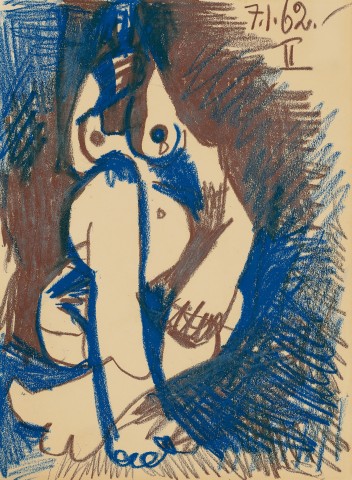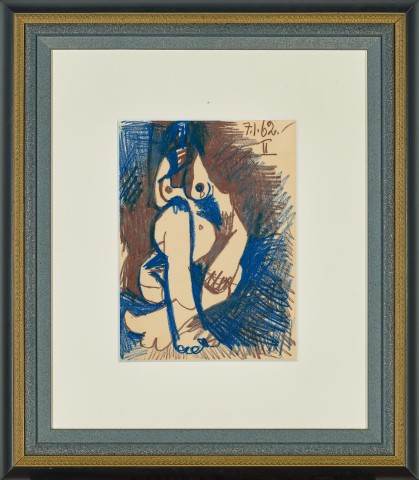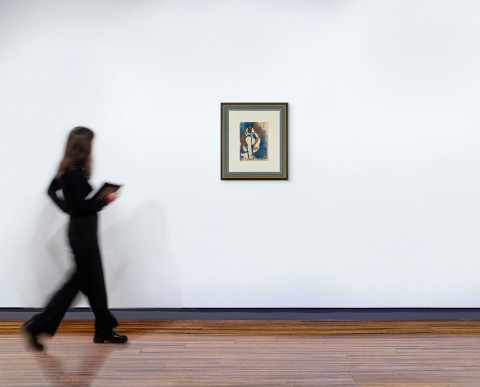NU ASSIS, 1962
PABLO PICASSO
coloured crayon on paper
32.0 x 24.0 cm (sheet)
dated and numbered upper right: 7.1.62 / II
bears inscription verso: 1091-3 / Z 20 uo 183
Estate of Pablo Picasso
Thence by descent, Marina Picasso Collection
Galerie Jan Krugier, Geneva
Private collection, Tokyo
Thence by descent
Private collection, Queensland
Zervos, C., Pablo Picasso, vol. 20, Oeuvres de 1961 à 1962, Editions Cahiers D'Art, Paris, 1968, no. 183, p.90 (illus.)
The Picasso Project (ed.), Picasso's Paintings, Watercolours, Drawings and Sculpture, The Sixties I, 1960-1963, Alan Wofsy Fine Arts, San Francisco, 2002, no. 62-004, p. 213 (illus. as 'Seated Nude')
Pablo Picasso’s last great era of furious creative energy, the ‘époque Jacqueline’1, was remarkable for its bold and self-reflexive interest in both the works of the great masters of art history and of his own, by now very extensive, oeuvre. At Mas Notre-Dame-de-Vie, the artist’s estate in Mougins on the slopes above Cannes purchased as a wedding gift to Jacqueline Roque in June 1961, Picasso used large sketchbooks in the studio, recording in a diaristic manner the preparative, intermediary and responsive drawings to his oil paintings of the same period. Recording his life’s work with minute and sequential detail, Picasso filled 175 separate notebooks, each providing crucial records to the artist's creative inventiveness, his detailed experimental processes and the interwoven development of the various artistic mediums he employed.
Within each private sketchbook, the drawings of each day mostly remained unsigned, and were simply annotated with the date, and numbered as each day progressed. These two coloured figure studies are two of three drawings in wax crayon made on the same day2, 7th January 1962, within the first few pages of notebook No. 166, titled “Dessins”, which Picasso had started fresh on the 5th of January.3 They are individual and intimate studies of seated female nudes, closely related to the artist’s ongoing and long-term thematic series: variations on Édouard Manet’s Déjeuner sur l’Herbe which featured figures in Picasso’s favourite poses, and the series of formal portraits of his new muse Jacqueline that were to follow. The progression of these studies is logical, intimately linked with the artist’s current artistic preoccupations, with forms reappearing and feeding into one another, moving from group compositions, to seated nudes, to formal portraits of the face and torso.
Realised in vigorous and emphatic outlines of contrasting cobalt blue and burnt umber coloured wax crayons, Picasso’s two voluptuous nudes are endowed with a strong sculptural quality. In coiled poses, these studies exhibit multiple points of view of the human female figure at once, the artist and viewer manipulating these planes into a cohesive and weighty physical presence. Picasso concertinas these multiple perspectives into one planar image, reusing techniques he had devised many years before within Analytical Cubism, here applied with the exceptionally confident and loose gestures of a seasoned master.
Jacqueline became the default subject for portraits and figure studies of this last phase of the artist’s career. In both drawings the head of the woman is small, foreshortened and receding into space and shadow while large, crossed legs and feet occupy the majority of the pictorial space. The first drawing (lot 35) of a nude seated on a blue chair presents a more clearly defined head in profile, endowed with Jacqueline’s recognisable aquiline nose and long dark hair. However, through over-emphasised sexual physical attributes, this seated nude becomes a symbolic archetype. Her raw fleshy contours, flanked and barely contained by the chair’s rectilinear structure, evoke the implied submissive position of the naked artist’s model and the pantomime of desire that played out in Picasso’s late works. In assertive lines drawn without revisions, the artist imposes his voyeuristic understanding of the woman’s body, paying close attention to her face and torso while broadly sketching the flattened and rounded morphology of the rest of her body.
Between 1959 – 1962, Picasso embarked on a themed cycle of works based on Édouard Manet’s 1861 scandalous masterpiece Déjeuner sur l’Herbe.4 Acknowledging Manet’s role as progenitor of Modern Art, Picasso freely adapted the format of observed female nudes in a bucolic setting as a vehicle to address his own ongoing theme of the ‘artist and model.’ The pages of his previous 1961 and following 1962 notebooks are almost completely subsumed by iterative variations of the recognisable fête champêtre, gleefully irreverent in their stylised reinterpretation. While not explicitly referencing Manet’s work, the second Seated Nude (lot 36) adopts a similar pose to the iconic figure of the Déjeuner. Here Picasso rotates Manet’s figure to be viewed from the front. Douglas Cooper remarked of this series: ‘[Picasso] takes special pleasure in pushing on beyond the point at which some other man stopped. So we find him turning things upside down or back to front, juggling with them’, in a demonstration of artistic and technical bravado.5 In a similar manner to Manet, Picasso highlights the nude’s powerful presence presenting through negative space her pale flesh stark against a brooding dark background. Translating the real physical presence of his seated model into a symbolic and universal nude, Picasso exerts his demiurgic power and reflects on the act of voyeurism as the starting point of creation.
1. Coined by Sir John Richardson KBE, British art historian and Picasso’s biographer, after his muse and last wife, Jacqueline Roque, whom Picasso married in 1961 and lived with from September 1954 until his death in 1973.
2. The third numbered drawing from 7th of January 1962 was a portrait study of Jacqueline, Tête appuyée sur la main, relating to recent painted portrait, Head of a Woman (Jacqueline), 18 December 1961 (private collection) and a concurrent portrait Woman in a Yellow Hat (Jacqueline), 19 December 1961 – 20 January 1962 (private collection).
3. Glimcher, A., and M. (eds.), The Sketchbooks of Picasso, Thames and Hudson, London, 1986, p. 344. The full notebook, No. 166, to which these drawings belonged was inherited by Picasso’s granddaughter Marina, with individual sheets later dispersed through her dealer Jan Krugier in Geneva.
4. See: Late Picasso: paintings, sculpture, drawings, prints 1953 – 1972, Tate Gallery, London, 1988, p. 70
5. Cooper, D., Pablo Picasso. Les Déjeuners, Editions Cercle d’Art, Paris, 1963 p. 11
LUCIE REEVES-SMITH


